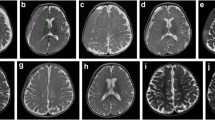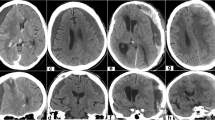Abstract
Introduction
Spontaneous parenchymal hemorrhage of term neonates is usually asymptomatic and does not require surgical intervention. However, there is no consensus on the management of cases with severe life-threatening symptoms, including repeated apnea, respiratory failure with severe cyanosis, severe bradycardia, or uncontrolled seizures.
Cases
Our medical records of term neonates with intracranial hemorrhage who underwent surgical intervention were retrospectively reviewed. There were two cases with spontaneous parenchymal hemorrhage. Both cases were delivered vaginally without any use of forceps or vacuum devices. Neither of them showed asphyxia, hypoxic-ischemic encephalopathy, hematological abnormalities, congenital vascular anomalies, infection, or birth trauma. Common symptoms included apnea, cyanosis, bradycardia, and decreased consciousness. The original location of bleeding was the parenchyma of the right temporal lobe. The hemorrhage extended to subdural spaces in both cases. Subdural hematoma (SDH) removal was performed without manipulating the parenchymal hematoma. Only a small amount of SDH (approximately 5 ml) was drained spontaneously with irrigation, which was sufficient to decrease the elevated intracranial pressure. The patients’ respiratory conditions improved dramatically after the surgery.
Conclusion
We propose that removing only a small amount of SDH would be effective and sufficient to relieve severe symptoms of increased intracranial pressure in term neonates with massive spontaneous parenchymal hemorrhage.




Similar content being viewed by others
References
Bergman I, Bauer RE, Barmada MA, Latchaw RE, Taylor HG, David R, Painter MJ (1985) Intracerebral hemorrhage in the full-term neonatal infant. Pediatrics 75:488–496
Brouwer AJ, Groenendaal F, Koopman C, Nievelstein RJ, Han SK, de Vries LS (2010) Intracranial hemorrhage in full-term newborns: a hospital-based cohort study. Neuroradiology 52:567–576
Cole L, Dewey D, Letourneau N, Kaplan BJ, Chaput K, Gallagher C, Hodge J, Floer A, Kirton A (2017) Clinical characteristics, risk factors, and outcomes associated with neonatal hemorrhagic stroke: a population-based case-control study. JAMA Pediatr 171:230–238
Derek AB (2001) Discussion: spontaneous intraparenchymal hemorrhage in full-term neonates. Neurosurgery 48:1048–1049
Gupta SN, Kechli AM, Kanamalla US (2009) Intracranial hemorrhage in term newborns: management and outcomes. Pediatr Neurol 40:1–12
Hanigan WC, Powell FC, Palagallo G, Miller TC (1995) Lobar hemorrhages in full-term neonates. Childs Nerv Syst 11:276–280
Hanigan WC, Powell FC, Miller TC, Wright RM (1995) Symptomatic intracranial hemorrhage in full-term infants. Childs Nerv Syst 11:698–707
Hong HS, Lee JY (2018) Intracranial hemorrhage in term neonates. Childs Nerv Syst 34:1135–1143
Huang AH, Robertson RL (2004) Spontaneous superficial parenchymal and leptomeningeal hemorrhage in term neonates. AJNR Am J Neuroradiol 25:469–475
Jhawar BS, Ranger A, Steven DA, Del Maestro RF (2005) A follow-up study of infants with intracranial hemorrhage at full-term. Can J Neurol Sci 32:332–339
Looney CB, Smith JK, Merck LH, Wolfe HM, Chescheir NC, Hamer RM, Gilmore JH (2007) Intracranial hemorrhage in asymptomatic neonates: prevalence on MR images and relationship to obstetric and neonatal risk factors. Radiology 242:535–541
Sandberg DI, Lamberti-Pasculli M, Drake JM, Humphreys RP, Rutka JT (2001) Spontaneous intraparenchymal hemorrhage in full-term neonates. Neurosurgery 48:1042–1048 discussion 1048-1049
Author information
Authors and Affiliations
Corresponding author
Ethics declarations
All procedures performed in this study were in accordance with the ethical standards of the institutional review board.
Conflict of interest
The authors declare that there is no conflict of interest.
Additional information
Publisher’s note
Springer Nature remains neutral with regard to jurisdictional claims in published maps and institutional affiliations.
Rights and permissions
About this article
Cite this article
Tamura, G., Inagaki, T. Removal of a minimal amount of subdural hematoma is effective and sufficient for term neonates with severe symptomatic spontaneous parenchymal hemorrhage. Childs Nerv Syst 35, 2237–2240 (2019). https://doi.org/10.1007/s00381-019-04114-2
Received:
Accepted:
Published:
Issue Date:
DOI: https://doi.org/10.1007/s00381-019-04114-2




